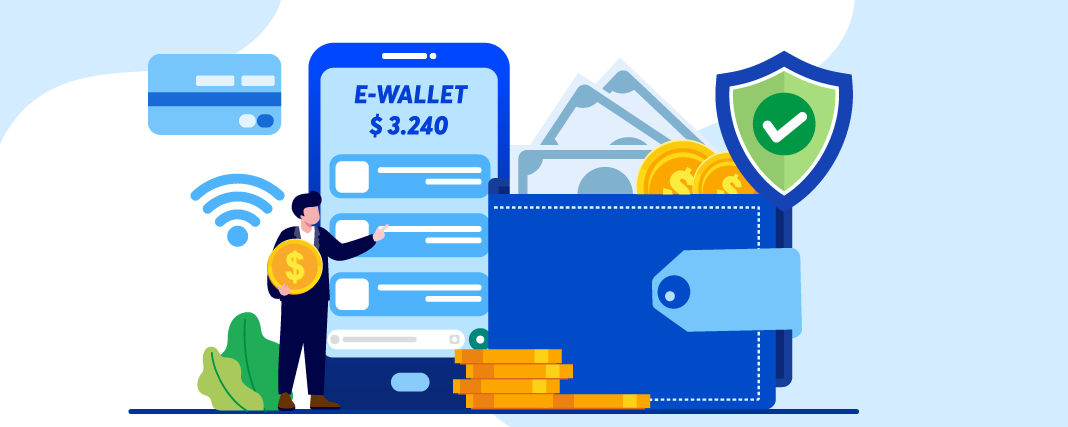With the emergence of smartphones, phones, quick internet access, and mobile banking, technology is progressing in the direction of digitizing payment systems. People have gradually switched away from traditional payment methods to highly advanced methods such as credit and debit cards, net banking, E-Wallets, etc. E-Wallet is proving to be a boon for users as it allows users to make easy online payments in a secure and convenient manner. It keeps track of all transactions and gives a variety of discounts and cashback.
According to the Global Forecast Report, the E-wallet sector will expand at a 15 % compound annual growth rate (CAGR) and will hit $2100 billion by 2023. The rising popularity of apps like GPay, Phonepe, Paytm, and others have proved that the mobile wallet app trend is here to stay. However, the increased rivalry in the digital payment app sector makes it harder for new competitors to establish themselves.
In this article, we’ll go over some helpful tips and necessary features for making your E-Wallet software popular and successful.
So let’s get started!
Top Tips to Make Your E-Wallet Mobile App Successful & Popular
- Conduct Market Research
Research is the first & foremost step for digital wallet app development. There are hundreds of other wallet apps on the market that provide exactly what you’re about to offer.
To create a roadmap for designing an app, you must research market trends and user expectations. You may go through the apps of your competitors and find out the benefits and drawbacks of their app solutions. You may take lessons from their errors and come up with a robust version.
- Provide All-in-one Digital Solution
When it comes to E-wallet application development, no aspect should be ignored. To support rapid, seamless, and reliable mobile-based transactions, all critical features and smooth functioning must be integrated into the software. To develop a user-friendly app with excellent performance, you may opt for the best mobile wallet app development company in the market.
- Top-notch Security
People are highly concerned about the safety of their sensitive financial data, so your E-Wallet payment software must be incredibly secure. Your E-Wallet mobile app will only be successful when your present and prospective clients can trust its data security framework. Hence, enable users to make payments only after completing an authentication process that includes a password, a one-time PIN, or biometric authentication. Using P2PE and tokenization, the stored data is encrypted and cannot be accessed by another device during the transaction. By effectively tackling the security issue, your application will become hack-proof and, as a result, gain market confidence.
- Maintain Ease & Convenience
E-Wallet apps are popular as they make people’s lives easier, therefore, improve the convenience of your E-Wallet fuel solution by enabling consumers to conduct transactions quickly and securely.
- Decide Payment Types & Mobile Platform
There are a multitude of platforms to choose from, including iOS, Android, Windows, and Blackberry. Select a platform based on the demographics of your target audience. Furthermore, the payment method is one of the many factors that influence the development of E-Wallet mobile applications. Three common online payment options are as follows:
- Online eCommerce payment: The most basic form of online payment
- Peer-to-peer (P2P) transfer: Customers can send money to each other using their smartphones.
- Point of sale (PoS): Customers make payment for something in a store using a mobile app.
- Pay Close Attention to Features & Functionality
To stay ahead of the competition, all aspects of the E-Wallet app should be valuable. Before establishing a set of features, you might undertake thorough research on industry trends and the needs and expectations of the target audience. Furthermore, even if your organization is constrained in some way, you should not neglect any basic functions during E-Wallet application development.
Necessary Features of E-Wallet Mobile Application
- User Registration
The most visible and commonly used element of an E-Wallet software solution is user registration. To accomplish this, the user will need to utilize his phone number and email address. A confirmation code will be sent to the applicant, that he must input in order to accomplish the registration procedure.s. Several E-Wallet applications even have a well-defined KYC (Know Your Customer) mechanism in order to ensure secure funds transfer.
- Bank Account Linking
Bank account linking is required for moving funds to/from your account, it is the most significant functionality to implement. Without associating their bank accounts, users can’t perform transactions or other transactions via the app. To link the bank account, users have to enter card information such as the CVV number and the card’s expiration date.
Moreover, people possess many debit/credit cards with multiple bank accounts hence maintaining your app’s ability to store all available cards.
- Wallet & Money Addition
A passbook should be included in your E-Wallet software so that customers may keep track of their transactions whenever they wish. The software must allow users to add money to their wallet by linking their bank account, credit/debit card.
- Send/Receive Fund
Using the E-Wallet mobile application users can easily send and receive money to and from anyone by just entering the recipient’s phone number or scanning a QR code. NFC or beacons can also be utilized to facilitate such transactions as an alternate technology. In addition, receiving funds goes through a similar procedure. Also, The money transfer from the payer wallet to the payee wallet occurs in seconds rather than hours or business days. Hence, this feature offers great benefits to the users.
- Fund Transfer to Bank
E-Wallet application development isn’t complete without bank and wallet integration. If a user does not want to keep extra money in his wallet, then using this feature he can transfer money from wallet to bank account. However, each E-Wallet software has a monthly usage limit. If the amount surpasses this limit, users will be unable to do any additional transactions.
- Utility Bill Payments
Today’s consumers choose to pay every bill online including electricity, loans, tuition, school, mortgages, rent, etc. Hence, the E-Wallet should be able to provide a straightforward solution for bill payments.
Other Advanced Features
- Cloud Integration
- In-built marketing tool
- Inventory, voucher & document management
- Multi-currency & multi-language support
- Integration with Wearable devices
- Virtual card generation and integration
- Data management
- Card insurance linked to a digital wallet
- Centralized CRM dashboard
- Location-based services
- Chatbot support
In A Nutshell
E-Wallet mobile apps are pretty much everywhere now. These E-wallet apps are more popular in developing countries. They are only becoming bigger and better in terms of facilitating transactions and payment processing. It’s no surprise that E-Wallet apps remain popular among a wide range of businesses.
Author – Bio
Nikunj Gundaniya, Product manager Digipay.guru, one of the leading fintech solution providers, which provides mobile finance application development services. He is a visionary leader whose flamboyant management style has given profitable results for the company. He believes in the mantra of giving 100% to his work.






